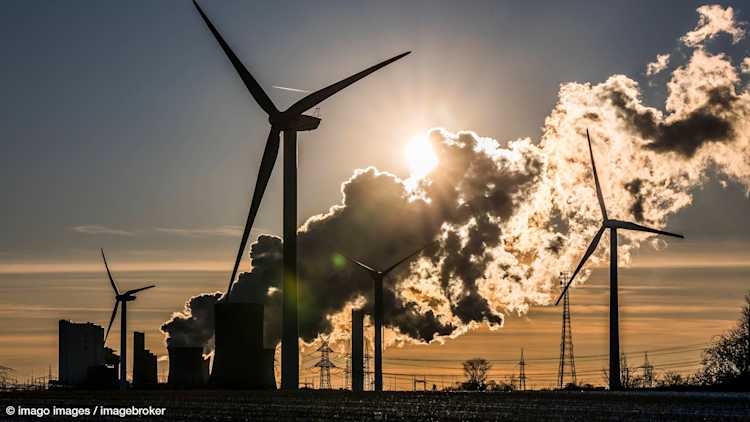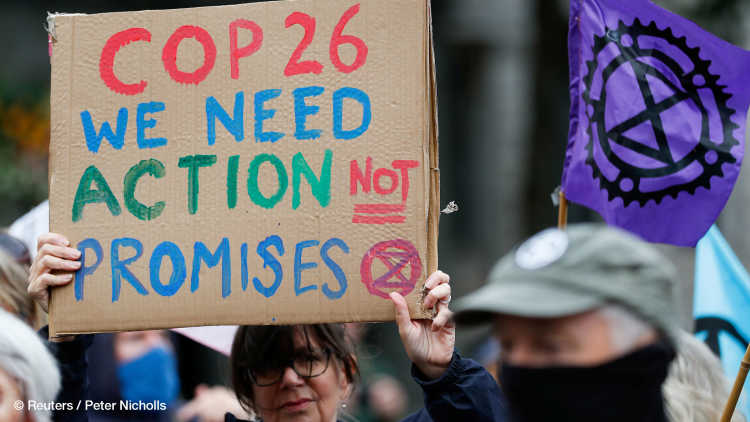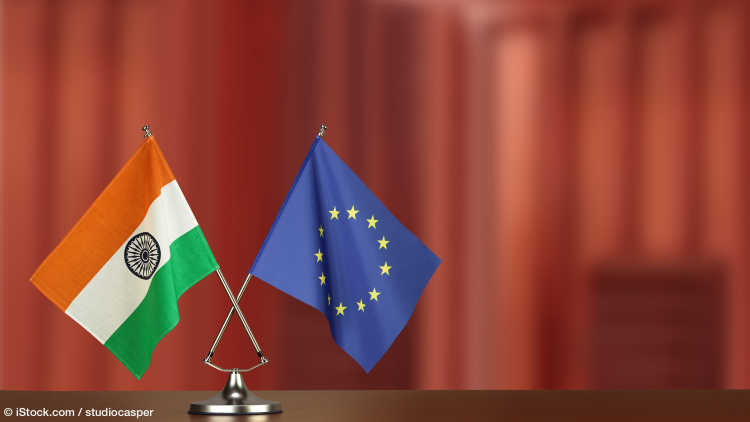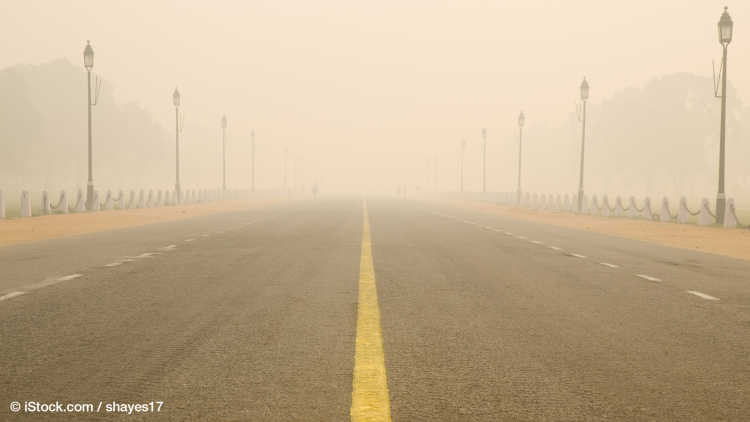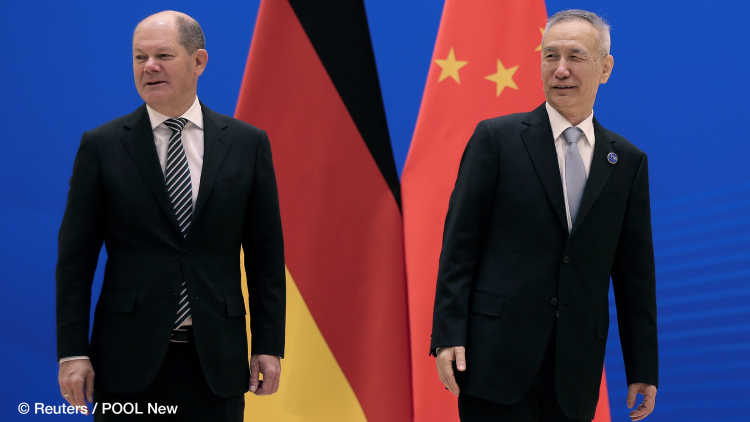- Startseite
- Publikationen
- GIGA Focus
- Competition and Cooperation: India and China in the Global Climate Regime
GIGA Focus Asien
Competition and Cooperation: India and China in the Global Climate Regime
Nummer 4 | 2022 | ISSN: 1862-359X
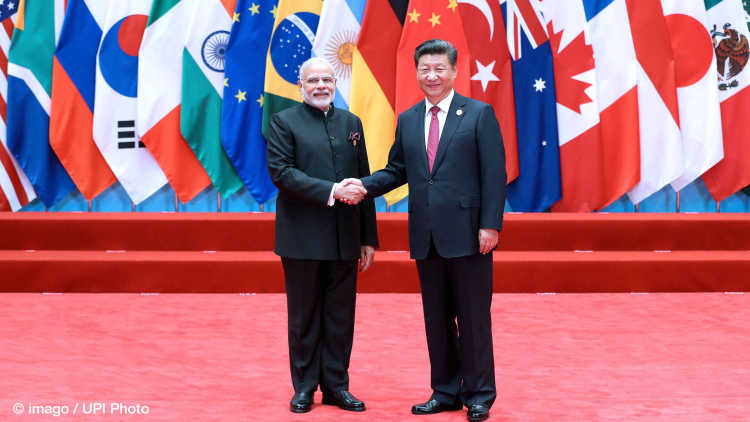
The need to cooperate in matters of climate change requires partnerships among states, such as India and China, that in other contexts are competitors – if not rivals. This simultaneity of cooperation and competition is one of the key features of the emerging multipolar order and should take centre stage for both policy and research.
Climate change is the key challenge for the coming decade, requiring cooperation from major emitters on mitigation, adaptation, climate finance, and the decarbonisation of the energy supply. No state will be able to achieve sufficient climate action alone.
Simultaneously, geopolitical and geo-economic tensions between these actors in the increasingly multipolar global order are growing, not only in today’s most obvious case of Ukraine but also on the Indo–Chinese border.
This juxtaposition of cooperation and conflict also plays out in the United Nations Framework Convention on Climate Change: at COP26 in 2021, India and China aligned to ensure that in the final agreement the commitment to a global coal phase-out became to a coal phase-down. Despite regional and global rivalry, cooperation at the intersection of issue-specific interests can yield both positive and negative outcomes.
For example, the decarbonisation of energy systems and the expansion of renewables, including solar power and (green) hydrogen offers such a field of competition over technology and trade leadership. This competition increasingly draws in the European Union and other global actors who are looking for new and reliable energy partners.
Policy Implications
Climate change is a global challenge and requires cooperation at that level. Germany and the EU have an important role in helping to foster such cooperation even despite clashes of values and interests. Engagement with India has been given greater impetus more recently, also regarding diversification of energy sources. In the face of escalating geopolitical tensions this will be more difficult in the case of China, though nevertheless still crucial to achieve the Paris goals.
Cooperation and Conflict Intersect in the Contemporary Global Order
Preventing dangerous climate change requires global cooperation. However, climate policy – like all policy fields – does not happen in a vacuum. For instance, increasing security tensions, as in the border region of China and India, affect all other areas of cooperation between the two states. Territorial conflicts between these Asian powerhouses have been going on since the start of the postcolonial era, first marked by a 1962 border war. Based on a joint border agreement, both states were able to reduce tensions in subsequent decades. Events peaked again when, in 2020, at least 20 Indian and at least four Chinese soldiers died in a confrontation in the Galwan valley. This caused considerable diplomatic tension and even concerns about broader military conflict in the region. In particular, China’s increasing infrastructure build-up in the area poses a threat to Indian interests, illustrated by a new bridge in Ladakh – a territory also claimed by India.
In addition, through various economic initiatives tied to its Belt and Road Initiative (BRI), Beijing has extended relations to Pakistan as well as other South Asian neighbours such as Nepal and Sri Lanka. While this causes anger in New Delhi, China claims that India is to blame for increasingly aggressive behaviour towards its neighbours, which hence find shelter under the Chinese economic umbrella. This growing polarisation of mutual security interests has, instead, strengthened India’s resolve to also engage in alliances whose members share a common interest in containing China. These include, for example, the QUAD (Quadrilateral Security Dialogue, consisting of the United States, Australia, Japan, and India), but also bilateral arrangements with other partner states and the European Union (EU).
At the same time, India and China are both members of the BRICS, which held their most recent event virtually during the Leaders’ Summit under the Chinese presidency on 23 and 24 June 2022. Both here and in other global forums and institutions, the two states have jointly argued for significant reform of multilateral institutions – further to setting up new ones too, including the New Development Bank which has expanded its membership beyond the BRICS more recently. An alignment of interests across multiple dimensions also led to both China and India abstaining at the United Nations Security Council and General Assembly (UNGA) respectively regarding Ukraine-related resolutions. This is primarily caused by a functional but expedient relationship with Russia, something both states share. At the same time, India’s positioning is also an expression of its foreign policy worldview, which strives for strategic autonomy and an independent path. This includes, as formulated by the Indian Foreign Minister, a stable Russia, which is achieved in the common interest with China (Jaishankar 2020: 123).
With the emergence of new centres of power, the development of new forms of multilateralism seem inevitable. Meanwhile, existing ones are being increasingly called into question by those new power centres when they feel insufficiently represented. It seems to be a central feature of the current global order that cooperation and conflict among state (and probably other) actors must go hand in hand. Successful solutions to both national and global challenges increasingly depend on the ability to accept this simultaneity, and, indeed, its inherent contradictions.
India’s and China’s Shared Climate Vulnerability
The two Asian giants are among the most important actors for global climate cooperation, not only in terms of their position as the largest (China) and third-largest (India) emitters of contemporary climate gases respectively (Crippa et al. 2020) but also of their vulnerability to climate change both today and in the future. This shared fate has become even more visible to the world in the past few months – for example, with a heat wave rolling over India and Pakistan since March 2022. Temperatures of up to 50 degrees Celsius have caused several dozen deaths due to so-called hyperthermia. Researchers also attribute this to the effects of climate change and assume that up to one billion people in India and Pakistan will be permanently exposed to the risk of extreme heat waves. Drought risks are an additional burden, especially for megacities such as Delhi or Shenzhen (IPCC 2022: 10–58). Similarly, unusually heavy monsoon rains have been evident in 2022, such as the massive floods in Assam that have so far cost over 120 people their lives and hundreds of thousands more their homes. These often escalate into further natural events, such as the landslides in north-eastern Manipur that have killed over 30 people. This comes after several devastating flood events throughout 2021.
The increased impact of such flood events – not least since affected areas are close to its own territory – is also a reality for China, as is the risk of simultaneous crop failure regarding maize – a threat estimated to have now increased by up to 40 per cent (IPCC 2022: 16–107). The most recent harbinger hereof occurred in June 2022, when around half a million people in southern China were affected by widespread flooding, resulting in massive infrastructure damage and evacuation measures. The International Panel on Climate Change (IPCC) estimates that four billion people, nearly half of whom live in India and China, will live under conditions of severe water scarcity for at least one month per year going forwards. Furthermore, the top Asian rice-producing countries (China and India included) face pests such as the golden apple snail proliferating with the increase in climatically suitable habitats (IPCC 2022: 10–14). Such living conditions would make many regions of both countries permanently uninhabitable, and the pressure on local politicians to act on climate change and implement adaptation measures is correspondingly great.
A Shared History of Climate Negotiations
Yet, commonalities vis-à-vis the global climate regime go beyond just mutual environmental and economic preconditions as well as vulnerabilities. India and China also share important negotiation positions historically formed, ones that have so far endured. This includes a strong investment in the language of the 1992 UN Framework Convention on Climate Change (UNFCCC) and its included principle of “Common but Differentiated Responsibilities and Respective Capacities.” The Convention shields developing countries, including India and China, from binding commitments regarding mitigation – but also with concern to other aspects of the climate regime, including related finance. India to a certain extent portrays itself – as does China – as a “heroic victim” (Prys-Hansen 2022: 156); in line with developing states in the Global South. Over the past few decades, this outlook has taken concrete form in the BASIC coalition (Brazil, South Africa, India, China).
In the context of the UNFCCC, the mentioned states are considered to be all non-Annex I countries to the Convention, also often articulating their role specifically as developing countries. Thus, they mainly argue for emission reductions by industrialised nations and reject own commitments to allow for economic development and poverty eradication first. However, as their own economic relevance increases this rhetoric of common but differentiated responsibilities becomes increasingly obsolete. In the run-up to COP21, held in Paris in 2015, China and India published a joint commitment to more far-reaching measures by announcing, in addition to the principles of the Kyoto Protocol, mutual cooperation on new technologies and ambitious nationally determined contributions (NDCs). Their concerted action aided the conclusion of the “Paris Agreement” signed a year later. Their potential for cooperation (whether for good or not) was further demonstrated by the fact that at COP26, held in Glasgow in 2021, both ensured behind the scenes that commitment to a coal phase-out now meant rather support for a coal phase-down, despite outrage among civil society but also some of the most vulnerable least developed countries. This cooperation has only been one of many illustrations of years of common positions on the question of coal.
A Mutual Rhetoric–Action Gap in Climate Policy
Both India and China have been lauded for their domestic efforts, for their leadership in South–South climate cooperation, and, generally, for their apparent ambition to drive global climate action. Some successes have indeed been achieved, accordingly attracting international attention. In October 2018, Prime Minister Narendra Modi received the “Champions of the Earth Award for Policy Leadership” from UN Secretary-General António Guterres, who praised him in particular for his vision of living in harmony with nature, as inspired by Mahatma Gandhi’s teachings, and his commitment to renewable energy, as achieved especially through the creation of the International Solar Alliance (ISA). Modi extended his country’s commitment to climate goals on the international stage with his much-noted speech at COP26, in which he pledged that India would achieve carbon neutrality by 2070. Although doubts arose about the validity thereof in light of scientific calls for global carbon neutrality by 2050, it was the first time India had made a concrete commitment to such a goal. In addition, Modi promised to take action on, by the year 2030, increasing non-fossil energy capacity to 500 gigawatts, meeting 50 per cent of energy requirements from renewables, reducing total projected carbon emissions by one billion tonnes, and bringing down the carbon intensity of India’s economy by more than 45 per cent.
These internationally announced targets are also reflected in national strategic plans, even in the context of major crises such as the COVID-19 pandemic. Similar to the EU’s “NextGenerationEU” - Recovery Plan, India’s COVID-19 stimulus package also sets ambitious targets by earmarking two-thirds of the funds for green transition processes – for example, around USD 3 billion for battery development and photovoltaics. Such future-oriented policy proposals are not only voiced by the national government but also resonate with local stakeholders. The city of Mumbai, particularly vulnerable due to its peninsular location, published a “Climate Action Plan” to achieve net zero emissions by 2050, which is more ambitious than the nationwide climate targets. This is to be helped by 50 per cent electricity generation from renewables by 2030 and 90 per cent by 2050 respectively.
In China, ambitious climate targets are not only represented by the Chinese Communist Party (CCP) on the international stage but also serve as an important means of domestic course-setting. For example, the “14th Five-Year Plan,” published in March 2021, included energy conservation and emissions reduction as key points (UNDP 2021). Similarly, it announced more ambitious NDCs for achieving the UN’s “Agenda 2030,” as well as faster and deeper decarbonisation thereafter. It remains to be seen how these long-term goals will influence the short-term policies of the Chinese party state under President Xi Jinping. A litmus test for the seriousness of these pronouncements may be the 20th National Congress of the CCP, which will be held in Beijing later this year. It is generally expected that Xi will be confirmed for a third term and potentially life. In this respect, this can be a signpost for whether he wants to be associated with national climate goals, and to what extent, regarding the future of the People’s Republic.
When it comes to the actual fulfilment of their promises on climate action, however, both states not only have room for expansion but in some instances have cast serious doubt on whether they are actually beginning to address domestically their commitments made at the global level. This is especially true for India, which currently holds last place in the “Environment Performance Index” (EPI) – a sustainability measurement calculated by the Yale Center for Environmental Law & Policy (Wolf et al. 2022). The authors mainly attribute this to the categories of “Air Quality” as well as “Biodiversity & Habitat,” in which India ranks second to last out of 180 countries. However, their findings met with resentment in New Delhi; the Ministry of Environment, Forest and Climate Change (2022) even questioned the results of the Index, as well as its indicators. This harsh reaction also exemplifies how concerned the Indian government is to preserve its “heroic victim” image.
In the case of China, a similar gap can be observed between ambitious climate targets and strong external communication on the one hand and the actual continuation of climate-damaging projects on the other. Such contradictions are also reflected in the EPI, in which China ranks 160th – another sobering conclusion in the face of its own imposed “climate leader” rhetoric (Wolf et al. 2022). One recent example is the “no overseas coal pledge,” announced in September 2021, which has led to the cancellation of 15 pre-construction projects on coal plants abroad, holding a capacity of 12.8 GW already. At the same time, 18 power plants with a total capacity of 19.2 GW could still be built, as they have already been approved and are thus in a grey zone (CREA 2022). Another, more all-encompassing dimension of this dualism is China’s roadmap to carbon neutrality, to succeed by 2060 – as announced by Xi at the UNGA in 2021. This will require major effort, especially against the backdrop of the importance of coal-fired power plants at home and unclear sustainability rules for central bank funding of energy projects. To put it simply: if India and China join forces, the realisation of at least some global climate goals is more likely; in the absence of their mutual cooperation, meanwhile, global climate cooperation is certain to fail.
Competition and Cooperation regarding Renewables
The simultaneity of cooperation and conflict and its effects also needs to be assessed against the recent backdrop of a global energy transition as well as of shifts in industrial production, trade, research, technology, and other areas of global concern. To swiftly meet these challenges, and that without neglecting economic and social dimensions, innovative but also reliable technologies are required. Renewable energies speak above all to such outcomes, on which both India and China are hence focusing going forwards. Besides climate change-induced existential concerns, economic motives also play an eminent role in driving this technological change.
Chinese Solar Dominance, and India’s Attempts to Challenge It
A striking example lies in the field of solar energy. While China is the largest solar manufacturer worldwide, India is aiming for ambitious solar targets in its national energy sourcing. Both countries have built up own industrial value chains in the solar sector, but Chinese companies dominate the global market while India continues to source many components from abroad. With escalating economic confrontation, there have already been several threats by companies on both sides to withdraw from each other’s respective market – including mutual recrimination. This trend is illustrated by the Indian government’s 2022 Budget, which envisages a gradual reduction in dependence on China in the solar sector.
Growing tensions can be traced back to, among other things, the Galwan valley clash and the onset of the current pandemic. The Indian government started to promote the principle of “self-reliance” (AatmaNirbhar Bharat), which stipulates both a larger involvement of India in geo-economic structures and, at the same time, national independence in key industries and consequently a reduction in imports from China. India’s shift revealed a strong dependence hitherto on China, not only in solar panels but also with regards to the import of cells and chips. Key Indian industrial players, such as ReNew Energy Global PLC, are therefore aiming to manufacture all relevant components in India to break China’s supremacy in the solar supply chain and thus end a long cycle of resource dependency – from oil to solar modules. Thereby, the private sector is working closely with the government and seeking its financial support for the transition (Dvorak 2021). Additionally, the focus on electric-vehicle battery production is also intended to attract foreign investors, for example from the field of electric mobility, and to take over market shares of the heavily subsidised Chinese solar industry.
As the solar market is still a crucial one, especially in the Global South, it will be important to see whether the intersection of interests here leads to synergies or, as in the described supply chain affairs, rather to increased competition between the two powerhouses. One vehicle for this can already be found in the earlier-mentioned ISA. Founded at the Paris Climate Conference in 2015 and based in Gurugram, the ISA aims to mobilise USD 1 trillion in investment vis-à-vis solar energy solutions by 2030. Within the framework of the Alliance, the first steps towards convergence were initially observed when China announced in 2017 at UNFCCC negotiations in Bonn that it would join the ISA.
Modi again invited China, in the person of Xi, to join the Alliance at the BRICS Summit 2018 in Johannesburg. Further, ISA Director Ajay Mathur renewed the invitation for both China’s and India’s other rival Pakistan (Bhaskar 2021). Nevertheless, China has not yet made a clear step towards joining the Alliance – likely due to India’s dominant position therein, which limits its neighbour’s overall claim to leadership in multilateral organisations. India has gained status through strong investment in the Alliance from Europe, especially France. The latter has contributed on a number of occasions to the ISA’s mission, including EUR 300 million in 2015, another EUR 700 million in 2018, and a further EUR 500 million in March 2019 (Shidore and Busby 2019: 5). The ISA is also striving to build the world’s first transnational solar grid, with India acting as the focal point for the latter’s construction and hence expanding its centrality in solar affairs (ISA 2022).
Hydrogen as a Contested Energy Source of the Future
But solar is not the only energy field in which the two rivals are pursuing divergent goals. Globally, interest and investment in green hydrogen as an energy source are on the increase. Regional powers try to translate this into political and economic capital, such as energy partnerships. An already-existing channel for this, especially in developing countries, is the ISA again, which is expected to facilitate the use and dissemination of hydrogen. Above all, this requires economic viability, safety, and reliability to meet the enormous public expectations that come with hydrogen supplies.
The framework to help India manage national expectations and achieve self-set climate targets is the National Hydrogen Mission (NHM), launched in August 2021. It should serve to standardise and bundle national hydrogen activities and bring science and industry closer together. Potential areas of green hydrogen application include fertiliser, steel, or petrochemicals as well as transport and industry schemes. At the same time, the Mission aims to develop India as a global hub for the whole value chain of hydrogen and fuel cell technology, which should contribute to Modi’s target of reaching energy independence by 2047. In this way, India would not only achieve its own climate targets and reduce the vulnerability of its territory but at the same time become a global technology leader and occupy an important market that regional rival China is also striving for. The People’s Republic also owns a forum for hydrogen management, the industry group China Hydrogen Alliance. In March 2022, it further announced a target of producing up to 200,000 tonnes of carbon-free green hydrogen by 2025. Hydrogen in China is currently still produced from around 80 per cent fossil fuels (Reuters 2022), which increases the pressure for a rapid shift towards green hydrogen. At the same time, Beijing needs to keep pace with its western neighbour and its far-reaching partnerships.
A Potential Energy Triangle Between China, India, and the EU
Increasingly, this economic and political competition in Asia is taking place with the involvement of external actors. The Indo–French ISA cooperation, for instance, exemplifies how India’s global action on climate change transcends traditional perceptions of a North–South divide. At the same time, this form of partnership also affects India’s relationship with the EU as a whole. This became clear during European Commission President Ursula von der Leyen’s visit in April 2022, wherein she emphasised India’s valuable role in the ISA – further to the general goal of deeper cooperation.
Race for Energy Partnerships across the Globe
The current geopolitical situation is favourable for India’s climate ambitions. Following the Russian invasion of Ukraine, the EU is keen to achieve energy independence and to forge new climate and energy partnerships. This is where India – as a formally democratic state with common strategic interests – comes in, with the opportunity now to build on existing relationships. A tradition of cooperation in the solar sector is not exclusive to India and France. In 2015, the German government under Chancellor Angela Merkel announced that it would provide EUR 2 billion to the newly elected Modi government for developing a clean energy corridor and various solar projects (NDTV 2015). As part of this process, the partnership is also turning to other energy sources. A symbol of this is the agreement on German–Indian hydrogen cooperation, reached during Modi’s visit in early May 2022 and signed by Germany’s Minister of Economic and Climate Affairs Robert Habeck and his Indian counterpart R. K. Singh respectively. As part of a multilateral climate policy aimed at comprehensive decarbonisation, but also in order to bind countries of the Global South closer to Western industrialised nations, the G7 countries agreed at the recent summit in Elmau to start negotiations on further “Just Energy Transition Partnerships” with India, Indonesia, Senegal, and Vietnam. Such a Partnership was already agreed with South Africa at COP26 and includes energy-policy reforms as well as billions of US dollars in financial aid to reduce the carbon intensity of national energy systems (G7 Germany 2022).
The fact that German Foreign Minister Annalena Baerbock is now calling for an enlargement of “hydrogen diplomacy,” including more in-depth energy partnerships, illustrates a new field of climate competition in which states vie for resources, financing, as well as international prestige. China and India have a key role to play here, both in terms of integrating into potential partnerships with other states that also generate financial support as well as of implementing technical solutions at home. Currently, the political momentum seems to be on India’s side, as the EU is turning away not only from Russia but also from China – especially in light of the ongoing diversification of its energy sources. Like many other regions, the EU is highly dependent on China in the solar sector, which accounted for 67 per cent of global module production in 2020. Efforts to avoid similar strategic failures regarding future technologies therefore take high priority.
Geopolitical Bloc Formation as a Threat to Global Climate Goals
One of the next opportunities to turn energy partnerships into real climate-policy action is COP27, which will take place in November 2022 in Sharm El-Sheikh, Egypt. The publication of the final report of the IPCC’s sixth assessment on climate change and the 77th Session of the UNGA, both scheduled for September 2022, are likely to be important indicators of the Conference’s objectives and their ultimate achievement or not. After COP26 was largely considered a failure, not least because of the alignment between China and India, there is great pressure on the actors represented to make progress. As the EU pursues increasingly ambitious climate goals internally, such as the elimination of the internal combustion engine, the question is whether its close partners like India will follow suit on the global stage.
Should this be the case, China would possibly be pushed into the role of a stumbling block to green development. Moreover, this would entail the danger of a new bloc forming in the UNFCCC – one which has less to do with climate policy goals and more so with geostrategic considerations. Likely coalitions here would be the Western industrialised nations on the one hand and China and Russia – both still heavily reliant on fossil fuels – on the other. At the same time, it would constitute a departure from India’s dual role as both regional power and advocate for developing countries’ economic development. This role is particularly relevant for the COP27 summit, which will also pay special attention to the African continent given the host. Considering the backdrop of increasing food shortages and rising global prices, the nexus of climate policy and poverty will also play a significant role. Here, China, India, and the EU all have considerable ambitions. However, recent developments in the Ukraine conflict and its political management, as described above, have shown that India is by no means willing to merely be a support wheel for the geopolitical ambitions of the EU or the US. The EU is therefore well advised to balance its interests wherever possible, and, despite major divergences with China on values, to keep dialogue formats open in order not to run into comparative cost disadvantages with its own climate goals.
This mediation role in the service of climate policy is a necessary but difficult balancing act. Geopolitical tensions, above all between the US and China, are rising sharply, and there is no sign that this will change any time soon. On the contrary, confrontation is likely to intensify – also against the backdrop of Chinese industries’ increasing disconnection from the world market. This potential for “decoupling” threatens not only the security of Western nations’ supply chains but also, indeed, their sustainability. Much of the manufacturing in the electrical sector and other key industries still takes place in China. The latter’s greater distancing from multilateral organisations and their sustainability ambitions could mean a shift away from clean production processes – with global implications. At the same time, the EU wants to secure its own manufacturing processes, for example in the semiconductor sector, to be strategically independent. In order to take all these interests into account, sensitivity and clear agreements on intersectional policy goals are necessary.
Considering the urgency of global cooperation on climate change, it is important that major emitters – even beyond the industrialised countries with their historical responsibilities – see eye to eye and find ways to cooperate in working towards a climate-safe future. Yet, strategic interests often undermine this need. It is mostly for reasons outside of climate change that India pursues a leadership role in related governance, as illustrated by the ISA but also the NHM, and reserves support in doing so in light of the EU’s drive towards a diversification of its own energy supply. The effect hereof on global climate cooperation at large is potentially troubling indeed.
Acknowledgement
I would like to thank Simon Kaack for his cooperation in researching and drafting this GIGA Focus.
Fußnoten
References
Bhaskar, Utpal (2021), ISA will be Delighted to have China, Pakistan as Its Members: Ajay Mathur, In: Livemint, accessed 21 March 2021.
CREA (Centre for Research on Energy and Clean Air) (2022), BRIEFING: 12.8 GW of Chinese Overseas Coal Projects Cancelled, But 19 GW Could Still Go Ahead, accessed 22 April 2022.
Crippa, Monika et al. (2020), Fossil CO2 Emissions of All World Countries – 2020 Report, Luxembourg: Publications Office of the European Union.
Dvorak, Phred (2021), India Seeks Its Own Solar Industry to Counter China, in: Wall Street Journal, accessed 15 December 2021.
G7 Germany (2022), Joining Forces to Accelerate Clean and Just Transition towards Climate Neutrality, 27 June, accessed 15 July 2022.
IPCC (Intergovernmental Panel on Climate Change) (2022), Climate Change 2022: Impacts, Adaptation, and Vulnerability, Contribution of Working Group II to the Sixth Assessment Report of the Intergovernmental Panel on Climate Change [Hans-Otto Pörtner et al. (eds)], Cambridge: Cambridge University Press.
ISA (International Solar Alliance) (2022), One Sun One World One Grid, accessed 3 July 2022.
Jaishankar, Subrahmanyam (2020), The India Way: Strategies for an Uncertain World, New Delhi: Harper Collins India.
MoEFCC (Ministry of Environment, Forest and Climate Change) (2022), Ministry of Environment, Forest and Climate Change Rebuts the Environmental Performance Index 2022 Released recently, accessed 8 June 2022.
NDTV (2015), Germany Offers India US $2.25 Billion for Solar, Clean Energy, accessed 5 October 2015.
Prys-Hansen, Miriam (2022), Politics of Responsibility: India in Global Climate Governance, in: Robert Falkner and Barry Buzan (eds), Great Powers, Climate Change and Global Environmental Responsibilities, Oxford: Oxford University Press.
Reuters (2022), China Sets Green Hydrogen Target for 2025, Eyes Widespread Use, accessed 23 March 2022.
Shidore, Sarang, and Joshua W. Busby (2019), One More Try: The International Solar Alliance and India’s Search for Geopolitical Influence, in: Energy Strategy Reviews, 26.
UNDP (United Nations Development Programme) (2021), Issue Brief – China’s 14th Five-Year Plan, accessed 23 July 2021.
Wolf, Martin et al. (2022), 2022 Environmental Performance Index, New Haven, CT: Yale Center for Environmental Law & Policy.
Gesamtredaktion GIGA Focus
Redaktion GIGA Focus Asien
Lektorat GIGA Focus Asien
Regionalinstitute
Forschungsschwerpunkte
Wie man diesen Artikel zitiert
Prys-Hansen, Miriam (2022), Competition and Cooperation: India and China in the Global Climate Regime, GIGA Focus Asien, 4, Hamburg: German Institute for Global and Area Studies (GIGA), https://doi.org/10.57671/gfas-22042
Impressum
Der GIGA Focus ist eine Open-Access-Publikation. Sie kann kostenfrei im Internet gelesen und heruntergeladen werden unter www.giga-hamburg.de/de/publikationen/giga-focus und darf gemäß den Bedingungen der Creative-Commons-Lizenz Attribution-No Derivative Works 3.0 frei vervielfältigt, verbreitet und öffentlich zugänglich gemacht werden. Dies umfasst insbesondere: korrekte Angabe der Erstveröffentlichung als GIGA Focus, keine Bearbeitung oder Kürzung.
Das German Institute for Global and Area Studies (GIGA) – Leibniz-Institut für Globale und Regionale Studien in Hamburg gibt Focus-Reihen zu Afrika, Asien, Lateinamerika, Nahost und zu globalen Fragen heraus. Der GIGA Focus wird vom GIGA redaktionell gestaltet. Die vertretenen Auffassungen stellen die der Autorinnen und Autoren und nicht unbedingt die des Instituts dar. Die Verfassenden sind für den Inhalt ihrer Beiträge verantwortlich. Irrtümer und Auslassungen bleiben vorbehalten. Das GIGA und die Autorinnen und Autoren haften nicht für Richtigkeit und Vollständigkeit oder für Konsequenzen, die sich aus der Nutzung der bereitgestellten Informationen ergeben.





